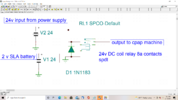MrDEB
Well-Known Member
We had another power outage last night and decided to look into a change over circuit.
cpath machine has an input of 90w 24v 3.75a
thinking of using a ryobi inverter power source.
I could use a 24v li-ion battery pack I had on my e-bike?
found this circuit https://www.circuitstoday.com/automatic-changeover-circuit
but max load is 2.5a
maybe put two in parallel? or even use a relay?
any thoughts on this project?
cpath machine has an input of 90w 24v 3.75a
thinking of using a ryobi inverter power source.
I could use a 24v li-ion battery pack I had on my e-bike?
found this circuit https://www.circuitstoday.com/automatic-changeover-circuit
but max load is 2.5a
maybe put two in parallel? or even use a relay?
any thoughts on this project?

